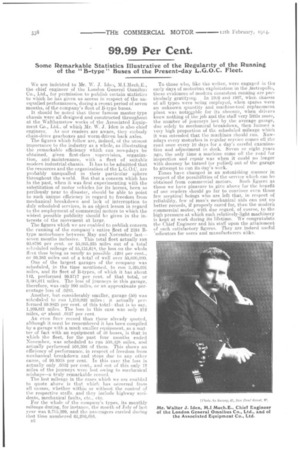99.99 Per Cent.
Page 4

If you've noticed an error in this article please click here to report it so we can fix it.
Some Remarkable Statistics Illustrative of the Regularity of the Running of the " B-type " Buses of the Present-day I.,.G.O.C. Fleet.
We are indebted to Air. W.
the chief engineer of the London General Omnibus Co., Ltd, for permission to publish certain statis.tics to which he has given us access in respect of the unequalled performances, during a recent period of seven months, of the company's fleet of B-type buses. It should be noted that these famous master-type chassis were all designed and constructed throughout at the Walthamstow works of the -Associated Equipment Ca., Ltd.. of which Mr. W. J. -Men is also chief engineer. As our readers are aware, they embody chain-drive gearboxes and worm-driven back -axles.
The figures which follow are, indeed, of the utmost importance to the industry a-s a whole, as illustrating the remarkable efficiency which can nowadays be obtained, given first-class supervision organization, and maintenance, with a fleet of suitable modern industrial chassis. It has to be admitted that the resources and the organization of the L.C.O.c. are p.;ohably unequalled in their particular sphere throughout the world. But that a concern which has in the past, when it was first experimenting with the substitution of motor vehicles for its horses, been so perilously near to disaster, should be able to point to such unique efficiency in regard to freedom from mechanical breakdown and lack of interruption to duly scheduled services, is an object lesson in regard to the employment of commercial motors to which thewidest possible publicity should be given in the interests of the movement at large. The figures which we are enabled to publish concern the running of the company's entire fleet of 2194: Btype motorbuses between May and November lastsev-en months inclusive. This total fleet actually ran 99.8796 per cent. or 55,065,235 miles out of a total scheduled mileage of 55,131,618, the loss on the whole fleet thus being as nearly as possible .1204 per cent., or 65,383 miles -out of a total of well over 55,000,000. One of the largest garages -of the company was scheduled, in the time mentioned, to run 3,495.001 miles, and its fleet of B-types, of which it has about 142, performed 99,9717 per cent. of that total, or 3,494,011 miles. The loss of journeys in this garage, therefore, was only 990 miles, or an approximate percentage loss of .0283.
Another, but considerably smaller, garage (50) was sch,eduld to run 1,210,022 miles ; it actually performed 99.9825 per cent, of this total—that is to say, 1,209821 miles. The loss in this case was only 212 miles, or about .0157 per cent.
An even finer record than those already quoted, although it roust be remembered it has been compiled by agarage with a much smaller equipment, as a matter of fact with an equipment of 40 buses, is that in which the fleet, for the past four months ended November, was scheduled to run 508,428 miles, and actually performed 508,395 of them. This shows an efficiency of performance, in respect of freed-om from mechanical breakdown and stops due to any other canse, of 99.9938 per cent. In this case the loss is actually only .0062 per cent., and out of this only 12 miles of the journeys were lost owing to mechanical mishaps—a truly remarkable re-cord.
The lost mileage in the cases which we are enabled to quote above is that which has occurred from all causes, whether within or withoutthe control of the respective staffs, and they include highway accidents, mechanical faults, etc., etc.
For the whole of the company's types, its monthly mileage during, for instance, the month of July of last year was 9,715,299, and the pasengers carried during that time numbered 52,286,088.
BG
To those who, like the writer, were engaged in the early days of motorbus exploitation in the ilaetropolis, these evidpances of modern consistent running are particularly gratifying.In 1006 and 1207, when chassis of all types were being employed, when spares were an unknown quantity and machine-tool replacement plant was notiu.lible for its absence, when drivers knew nothing of the job and the staff very little more, the number of journeys lost by the average garage, due solely to mechanical breakdown, then formed a very high proportion of the scheduled mileage which it was intended that the ma-chines should run. Nowa-days every motorbus in regular service comes off the road once every 10 days for aday's careful examination and adjustment in dock. Seven or eight years ago, the only time a machine came ofr the road for inspection and repair was when it could no longer Ivithdecency be turned (or Dulled) out of the garage to attempt to run its day's work.
Times have changed in an astonishing manner in respect of the possibilities of the -service which can be
obtained from commercial motors. Such figures as those we have pleasure to give above for the benefit of our readers should go far to convince even those few sceptical beings who are left that., in respectof reliability, few of man's mechanical aids can put uti better records, if properly eared for, than the modern commercial motor, with due regard, of course, to the high pressure at which such relatively-light machinery is kept at work during its lifetime. We congratulate the Chief Engineer and his staff upon the attainment of such satisfactory figures. They are indeed useful *ndicators for users and manufacturers alike.




















